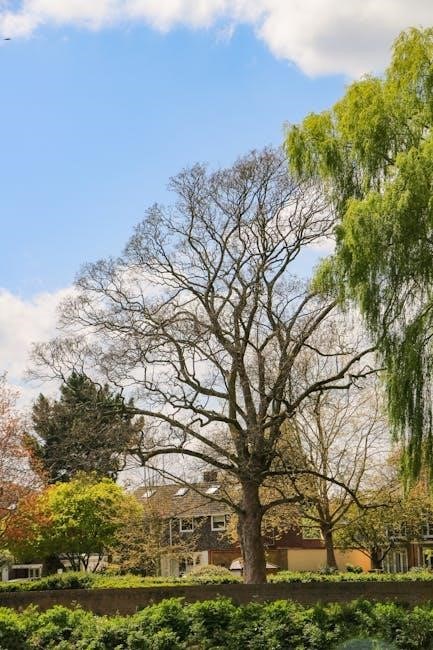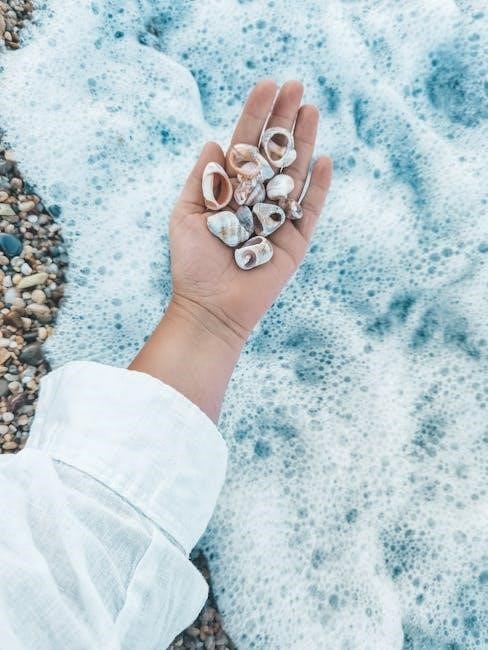Blue Willow China is a timeless ceramic pattern depicting a romantic narrative of love and escape, originating in 18th-century England, with designs inspired by Chinese motifs.
1.1 History and Origins of the Blue Willow Pattern
The Blue Willow pattern traces its origins to late 18th-century England, where it was inspired by Chinese motifs. The design depicts a romantic narrative of love and escape, set against a backdrop of willow trees, water, and pavilions. Thomas Turner is credited with creating the first Blue Willow pieces in 1790. The pattern quickly gained popularity and was replicated by prominent manufacturers like Spode and Royal Worcester. Its timeless appeal led to global production, with variations emerging in the U.S. and Japan. Despite its evolution, the core imagery remains consistent, making it a beloved and recognizable design for over two centuries.
1.2 Enduring Popularity of Blue Willow China
Blue Willow China’s enduring popularity stems from its timeless design, blending romance with cultural charm. Its iconic imagery of willow trees, bridges, and distant pagodas evokes a sense of nostalgia and elegance. The pattern’s versatility across various tableware and decorative pieces has made it accessible to different tastes and settings. Collectors appreciate its historical significance and aesthetic appeal, while everyday users enjoy its classic beauty. The pattern’s widespread production by numerous manufacturers has ensured its availability, contributing to its lasting allure. This balance of artistry and accessibility has cemented Blue Willow China as a cherished choice for both collectors and homeowners for centuries.
Identifying Blue Willow China
Identifying Blue Willow China involves examining patterns, marks, and condition. Look for distinctive willow, bridge, and bird motifs. Colors and signatures can help determine authenticity and age.
2.1 Traditional vs. Variant Patterns
Traditional Blue Willow patterns feature iconic motifs like the willow tree, bridge, and birds, rendered in blue on a white background. Variant patterns may introduce additional colors or design elements, such as pink, red, or green accents, or alternate border designs. These variations can impact value, with rare or unique designs commanding higher prices. Understanding these differences is crucial for collectors to authenticate and appraise pieces accurately. Traditional patterns are often more sought after, while variants offer diversity for enthusiasts. Both types showcase the artistic evolution of Blue Willow china, making each piece distinct and valuable in its own right.
2.2 Understanding Marks and Signatures
Identifying marks and signatures is essential for determining the origin and age of Blue Willow pieces. English manufacturers often used backstamps with their names or logos, while unmarked pieces may be American or Japanese. The presence of “Made in England” or “Royal Worcester” signifies high-value items. Variations in marks, such as hand-painted signatures, can indicate artisanal craftsmanship. Some pieces may lack marks, which can lower their value but not negate their authenticity. Over time, marks have evolved, reflecting changes in production and regulations. Collectors should study these markings closely, as they are key to authenticating and valuing Blue Willow china effectively.
2.3 The Role of Color and Condition in Identification
The color and condition of Blue Willow china play a significant role in its identification and value. The iconic blue hue should be rich and consistent, with intricate details clearly visible. Fading or uneven coloring may indicate reproduction pieces. Condition is equally important, as chips, cracks, or wear can drastically reduce value. Mint-condition items with no restoration are highly prized. Collectors should inspect for signs of aging, such as crazing or glaze wear, which can confirm authenticity. The interplay of vibrant color and pristine condition often determines the desirability and value of Blue Willow pieces in the collector’s market.
Valuation of Blue Willow China
Valuation of Blue Willow china depends on rarity, age, and condition. Antique English pieces from the 1800s are highly sought after, while modern reproductions hold less value.
3.1 Factors Affecting Value: Rarity, Age, and Condition
The value of Blue Willow china is significantly influenced by its rarity, age, and condition. Rare pieces, such as early 18th-century English examples, command higher prices due to their scarcity. Age plays a crucial role, with older items, particularly those from the 18th and 19th centuries, being more valuable. Condition is equally important; undamaged, mint-condition pieces retain higher value. Chips, cracks, or wear can drastically reduce a piece’s worth. Additionally, provenance and historical significance can enhance value, making certain items highly sought after by collectors.
3.2 Market Trends and Demand
Blue Willow china remains a popular collectible, with market trends showing consistent demand driven by nostalgia and aesthetic appeal. Prices range from $10 for common pieces to over $1,000 for rare items. Dinner plates and servingware are highly sought after, while rare variations and early English examples attract serious collectors. The market favors undamaged, antique pieces, especially those from the 1800s; Modern reproductions, including American and Japanese versions, are less valuable due to mass production. Online platforms and auctions reflect these trends, with collectors willing to pay premium prices for mint-condition, historically significant items, ensuring Blue Willow china remains a desirable investment.

Collecting Blue Willow China
Collecting Blue Willow China offers a blend of history and beauty, appealing to both beginners and seasoned collectors, with its iconic designs and timeless charm.
4.1 Tips for Starting a Collection
Starting a Blue Willow collection begins with research and understanding the pattern’s history. Begin by identifying traditional and variant designs, as well as marks and signatures. Set a budget and focus on pieces that resonate with your interests. Prioritize condition; mint pieces with no chips or fading hold higher value. Consider starting with common, affordable items like plates or bowls before pursuing rarer pieces. Join collector communities or forums for guidance and networking. Finally, invest in a reputable guidebook, such as Mary Frank Gaston’s Blue Willow Identification & Value Guide, for comprehensive insights and tips.
4.2 Essential Pieces to Look For
When building a Blue Willow collection, focus on essential pieces that showcase the pattern’s classic design. Plates, bowls, and pitchers are versatile and widely available. Platters, serving dishes, and teacups are also popular choices. Rare items like tureens, gravy boats, and candlesticks add unique charm. Look for pieces with vibrant blue hues and crisp details, as these retain higher value. English Blue Willow from the 1800s is particularly sought after. Avoid damaged or faded items unless they are rare. Consider collecting a complete set, such as a dinner service, for a cohesive display. These pieces form the foundation of a meaningful and valuable Blue Willow collection.

4.3 Care and Maintenance of Blue Willow China

Proper care is essential to preserve the beauty and value of Blue Willow China. Handle pieces gently to avoid chips or cracks, as damage lowers their worth. Clean items with mild soap and warm water, avoiding abrasive cleaners or scrubbers. Dry thoroughly to prevent water spots. Store china in a cool, dry place, away from direct sunlight, which can fade colors. Use acid-free tissue or cloth to wrap items for storage. Avoid stacking pieces to minimize risk of damage. For display, use sturdy shelves or cabinets. Regular dusting with a soft cloth keeps the china looking its best. Proper maintenance ensures your collection remains pristine and valuable for generations.
4.4 Where to Find Blue Willow Pieces
Blue Willow China can be found at estate sales, antique shops, flea markets, and online platforms like eBay and Etsy. Specialty collectible stores often carry vintage pieces, while auctions may offer rare or unique items. Thrift stores and charity shops occasionally have hidden gems. Online forums and collector communities provide tips and leads. Social media groups dedicated to Blue Willow enthusiasts also share discoveries. For rare pieces, consider consulting antique dealers or attending specialized auctions. Online marketplaces like Ruby Lane and Chairish often feature high-quality, verified items. Joining collector clubs can also connect you with sellers and experts in the field.

Key Resources for Collectors
Essential resources include books like Blue Willow by Mary Frank Gaston and Collecting Blue Willow by M. A. Harman, offering detailed guides and price insights.
5.1 Recommended Books on Blue Willow Identification
Several books are indispensable for collectors, including Blue Willow: An Identification and Value Guide by Mary Frank Gaston, offering detailed history and over 650 color photographs of various pieces. Another essential resource is Collecting Blue Willow: Identification & Value Guide by M. A. Harman, featuring nearly 500 images of Willow Ware items, from everyday dishes to rare pieces. These books provide comprehensive insights into traditional and variant patterns, marks, and dating techniques, making them invaluable for both novice and experienced collectors aiming to identify and appraise Blue Willow china accurately.
5.2 Online Platforms for Buying and Selling
Online platforms like eBay and Etsy are excellent for buying and selling Blue Willow china, offering a wide range of pieces from rare antiques to modern reproductions. eBay provides a global marketplace with detailed listings, including prices for sold items, helping collectors gauge value. Etsy specializes in vintage and unique items, ideal for finding rare or specific Blue Willow pieces. Additionally, online forums and social media groups dedicated to Blue Willow collectors offer valuable insights and opportunities to connect with other enthusiasts. These platforms simplify the process of locating and purchasing Blue Willow china, making them essential tools for collectors worldwide.
